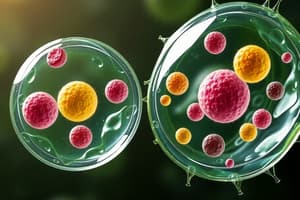Podcast
Questions and Answers
What is the primary function of the rough endoplasmic reticulum?
What is the primary function of the rough endoplasmic reticulum?
- Production of lipids
- Cell division support
- Storage of genetic information
- Production and transportation of proteins (correct)
Which organelle is responsible for processing, sorting, and tagging proteins for shipping?
Which organelle is responsible for processing, sorting, and tagging proteins for shipping?
- Ribosomes
- Vesicles
- Nucleus
- Golgi apparatus (correct)
What do prokaryotic cells lack that differentiates them from eukaryotic cells?
What do prokaryotic cells lack that differentiates them from eukaryotic cells?
- Nucleus (correct)
- Genetic material
- Cell membrane
- Ribosomes
Which of the following is NOT a function of the cytoskeleton?
Which of the following is NOT a function of the cytoskeleton?
Which structure within a cell functions to store and transport materials?
Which structure within a cell functions to store and transport materials?
What type of cells contain membrane-bound organelles?
What type of cells contain membrane-bound organelles?
Which component is found in all cells, regardless of being prokaryotic or eukaryotic?
Which component is found in all cells, regardless of being prokaryotic or eukaryotic?
Which of the following structures aids in cell division?
Which of the following structures aids in cell division?
What is the primary function of mitochondria in a cell?
What is the primary function of mitochondria in a cell?
Which of the following structures is found specifically in plant cells?
Which of the following structures is found specifically in plant cells?
What is meant by selective permeability of the cell membrane?
What is meant by selective permeability of the cell membrane?
How do vacuoles function within plant cells?
How do vacuoles function within plant cells?
What role do centrioles play during cell division?
What role do centrioles play during cell division?
What is the concentration gradient?
What is the concentration gradient?
What is the primary function of chloroplasts in plant cells?
What is the primary function of chloroplasts in plant cells?
Which organelle is associated with breaking down materials within the cell?
Which organelle is associated with breaking down materials within the cell?
Which transport mechanism requires energy to move substances across the cell membrane?
Which transport mechanism requires energy to move substances across the cell membrane?
What occurs during exocytosis?
What occurs during exocytosis?
In a hypertonic solution, what is likely to happen to plant cells?
In a hypertonic solution, what is likely to happen to plant cells?
Which of the following statements about osmosis is correct?
Which of the following statements about osmosis is correct?
Which condition is characterized by same concentration of solute inside and outside the cell?
Which condition is characterized by same concentration of solute inside and outside the cell?
Which term describes the condition when plant cells swell but do not burst?
Which term describes the condition when plant cells swell but do not burst?
What does facilitated diffusion require for molecules to pass through a membrane?
What does facilitated diffusion require for molecules to pass through a membrane?
When a plant cell is placed in a hypotonic solution, what process occurs?
When a plant cell is placed in a hypotonic solution, what process occurs?
Flashcards are hidden until you start studying
Study Notes
Cell Theory
- All organisms are composed of cells.
- The cell is the most basic unit of life.
- All cells are produced by pre-existing cells.
Two Cell Types
- Eukaryotic cells: Have a nucleus and membrane-bound organelles.
- Prokaryotic cells: Lack a nucleus and membrane-bound organelles.
Cell Organelles
- Cytoskeleton: Provides strength and shape, positions organelles, assists in cell division, and aids in cell movement.
Cytoskeleton Components
- Microtubules
- Intermediate filaments
- Microfilaments
Protein Production, Modification, and Transportation
- Nucleus: Stores genetic information (DNA).
- Endoplasmic reticulum (ER):
- Rough ER (RER): Produces and transports proteins.
- Smooth ER (SER): Produces lipids, neutralizes toxins.
Cell Organelles Continued
- Ribosomes: Link amino acids to form proteins.
- Vesicles: Small, membrane sacs that store and transport materials.
- Golgi apparatus: Processes, sorts, and tags proteins for shipping.
Other Organelles
- Mitochondria: Produce energy for the cell (ATP).
- Vacuoles: Membrane-bound sacs that store water or other materials (common in plant cells).
- Lysosomes: Contain digestive enzymes for breaking down materials.
- Centrioles: Help divide DNA during mitosis and form cilia and flagella for movement.
Organelles Specific to Plant Cells
- Cell wall: Provides rigid support.
- Chloroplasts: Convert solar energy to chemical energy (photosynthesis).
Cell Membrane
- Fluid Mosaic Model: Allows only certain substances to cross (selective permeability).
- Enables communication with the outside environment.
Cell Transport
- Concentration: Amount of solute per unit volume of solution.
- Concentration gradient: Difference in concentration between two areas.
Passive Transport
- Diffusion: Movement of molecules from high to low concentration.
- Facilitated diffusion: Diffusion with the help of transport proteins.
- Equilibrium: State where concentration is equal throughout.
Active Transport
- Protein pumps: Use energy to move molecules against their concentration gradient.
- Bulk Transport:
- Endocytosis: Bringing materials into the cell.
- Exocytosis: Releasing materials from the cell.
Osmosis
- Movement of water across a selectively permeable membrane from an area of high water concentration to an area of low water concentration.
Tonicity
- Hypotonic: Solution with lower solute concentration compared to the cell.
- Hypertonic: Solution with higher solute concentration compared to the cell.
- Isotonic: Solution with equal solute concentration compared to the cell.
Osmosis & Tonicity in Animal Cells
- Hypotonic: Cell swells and may burst (cytolysis).
- Hypertonic: Cell shrinks (plasmolysis).
- Isotonic: Cell remains at equilibrium.
Osmosis & Tonicity in Plant Cells
- Hypotonic: Cell becomes turgid (firm).
- Hypertonic: Cell becomes flaccid (soft) or plasmolyzed (shrinking).
- Isotonic: Cell is slightly flaccid.
Studying That Suits You
Use AI to generate personalized quizzes and flashcards to suit your learning preferences.



